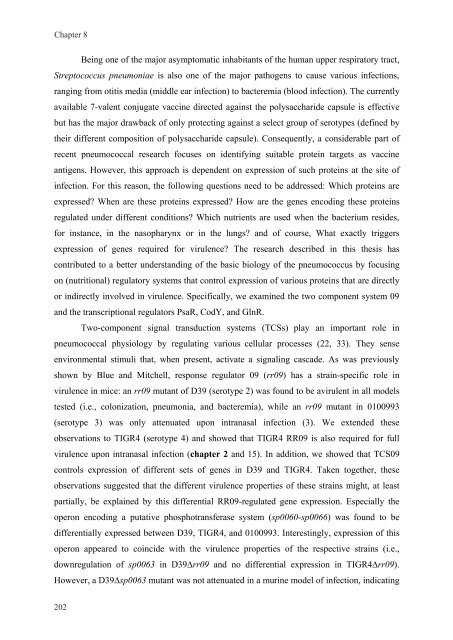Gene regulation in Streptococcus pneumoniae - RePub - Erasmus ...
Gene regulation in Streptococcus pneumoniae - RePub - Erasmus ...
Gene regulation in Streptococcus pneumoniae - RePub - Erasmus ...
Create successful ePaper yourself
Turn your PDF publications into a flip-book with our unique Google optimized e-Paper software.
Chapter 8<br />
202<br />
202<br />
Be<strong>in</strong>g one of the major asymptomatic <strong>in</strong>habitants of the human upper respiratory tract,<br />
<strong>Streptococcus</strong> <strong>pneumoniae</strong> is also one of the major pathogens to cause various <strong>in</strong>fections,<br />
rang<strong>in</strong>g from otitis media (middle ear <strong>in</strong>fection) to bacteremia (blood <strong>in</strong>fection). The currently<br />
available 7-valent conjugate vacc<strong>in</strong>e directed aga<strong>in</strong>st the polysaccharide capsule is effective<br />
but has the major drawback of only protect<strong>in</strong>g aga<strong>in</strong>st a select group of serotypes (def<strong>in</strong>ed by<br />
their different composition of polysaccharide capsule). Consequently, a considerable part of<br />
recent pneumococcal research focuses on identify<strong>in</strong>g suitable prote<strong>in</strong> targets as vacc<strong>in</strong>e<br />
antigens. However, this approach is dependent on expression of such prote<strong>in</strong>s at the site of<br />
<strong>in</strong>fection. For this reason, the follow<strong>in</strong>g questions need to be addressed: Which prote<strong>in</strong>s are<br />
expressed? When are these prote<strong>in</strong>s expressed? How are the genes encod<strong>in</strong>g these prote<strong>in</strong>s<br />
regulated under different conditions? Which nutrients are used when the bacterium resides,<br />
for <strong>in</strong>stance, <strong>in</strong> the nasopharynx or <strong>in</strong> the lungs? and of course, What exactly triggers<br />
expression of genes required for virulence? The research described <strong>in</strong> this thesis has<br />
contributed to a better understand<strong>in</strong>g of the basic biology of the pneumococcus by focus<strong>in</strong>g<br />
on (nutritional) regulatory systems that control expression of various prote<strong>in</strong>s that are directly<br />
or <strong>in</strong>directly <strong>in</strong>volved <strong>in</strong> virulence. Specifically, we exam<strong>in</strong>ed the two component system 09<br />
and the transcriptional regulators PsaR, CodY, and GlnR.<br />
Two-component signal transduction systems (TCSs) play an important role <strong>in</strong><br />
pneumococcal physiology by regulat<strong>in</strong>g various cellular processes (22, 33). They sense<br />
environmental stimuli that, when present, activate a signal<strong>in</strong>g cascade. As was previously<br />
shown by Blue and Mitchell, response regulator 09 (rr09) has a stra<strong>in</strong>-specific role <strong>in</strong><br />
virulence <strong>in</strong> mice: an rr09 mutant of D39 (serotype 2) was found to be avirulent <strong>in</strong> all models<br />
tested (i.e., colonization, pneumonia, and bacteremia), while an rr09 mutant <strong>in</strong> 0100993<br />
(serotype 3) was only attenuated upon <strong>in</strong>tranasal <strong>in</strong>fection (3). We extended these<br />
observations to TIGR4 (serotype 4) and showed that TIGR4 RR09 is also required for full<br />
virulence upon <strong>in</strong>tranasal <strong>in</strong>fection (chapter 2 and 15). In addition, we showed that TCS09<br />
controls expression of different sets of genes <strong>in</strong> D39 and TIGR4. Taken together, these<br />
observations suggested that the different virulence properties of these stra<strong>in</strong>s might, at least<br />
partially, be expla<strong>in</strong>ed by this differential RR09-regulated gene expression. Especially the<br />
operon encod<strong>in</strong>g a putative phosphotransferase system (sp0060-sp0066) was found to be<br />
differentially expressed between D39, TIGR4, and 0100993. Interest<strong>in</strong>gly, expression of this<br />
operon appeared to co<strong>in</strong>cide with the virulence properties of the respective stra<strong>in</strong>s (i.e.,<br />
down<strong>regulation</strong> of sp0063 <strong>in</strong> D39∆rr09 and no differential expression <strong>in</strong> TIGR4∆rr09).<br />
However, a D39∆sp0063 mutant was not attenuated <strong>in</strong> a mur<strong>in</strong>e model of <strong>in</strong>fection, <strong>in</strong>dicat<strong>in</strong>g

















